Article
Book Reviews: All 3 on the American Dream
Author(s):
These 3 books have been meticulously researched but succeed beyond their simple statistics to present compelling portraits of their subjects and what they have contributed to the success or failure of the American Dream.
Editor’s Note: Like all good writers, columnist Eric Anderson, MD, spends a good deal of his time reading. A retired physician, he filed the following reviews of 3 books, each with a different connection to “The American Dream.”
Walter Isaacson has followed up his biography Steve Jobs with another triumph, this time a tribute to all the eclectic mix of scientists and engineers and dreamers and odd-men-out who conceived that, one day, machines—computers—would work to do man’s bidding. That one day a man or woman could sit down at a desk, press a button and, for their immediate use, conjure up all the wisdom of the world. Fast.
Those who spend their days with fingers dancing over keyboards or ears stuck against smartphones may believe they already know something about the story of the Digital Revolution: they are somewhat acquainted with the tale of rivals Bill Gates and Steve Jobs—and a recent movie may have made the name of Alan Turing more familiar to them, but the full saga of what brought us both the computer and the Internet is much, much more complicated.
The Innovators is a delightful, engrossing study but it is not the easiest of reads. Isaacson has meticulously researched his book and the cast is almost overwhelming because the author knows who deserves credit for each advance and is determined to give them their due. His first accolades are to one Ada, Countess of Lovelace who, born in 1815 as the only legitimate daughter of the romantic poet Lord Byron, discovered she had an immense appetite for mathematics and science. She was fascinated by the Industrial Revolution. The book opens with her contributions and ends with her observations that, working with machines, humans remain relevant because they possess imagination.
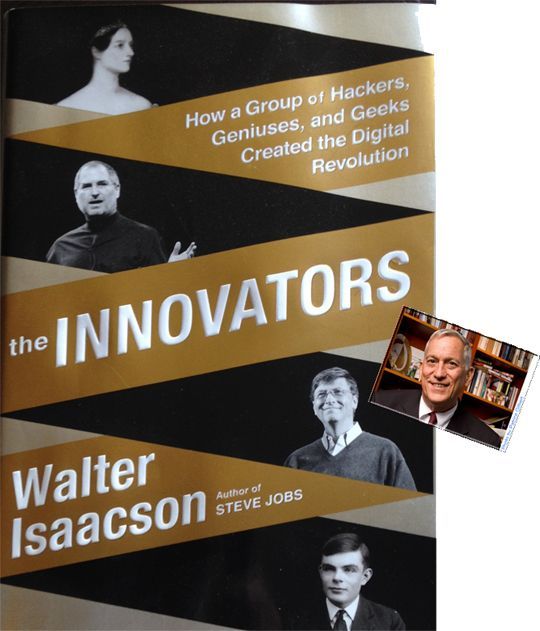
Isaacson‘s father was an electrical engineer, his mother a realtor. A former CEO of CNN and managing editor of TIME, Isaacson has written acclaimed biographies including those of Benjamin Franklin and Albert Einstein. He graduated from Harvard in 1974 and was a Rhodes Scholar at Oxford. His blockbuster biography Steve Jobs was published in October 2011 and The Innovators 3 years later in October 2014. (Photo of Walter Isaacson by Patrice Gilbert.)
Isaacson is a polished observer. And methodical; he has a vast field to plough and never loses his focus. He is painstaking at giving credit to many discoveries but repeatedly points out progress is often made because of the combined efforts of many collaborators whether college hippie friends at work in a garage or engineering co-workers on the line at Bell Labs. Says Isaacson, “Visionaries who lack such teams around them often go down in history as mere footnotes.”
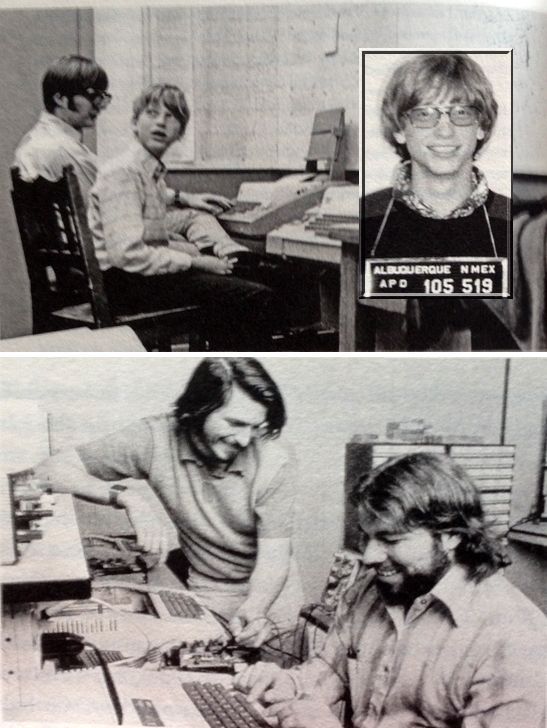
Top image: Paul Allen and Bill Gates in Lakeside School computer room (photo credit Bruce Burgess, Lakeside School.) Gates arrested for speeding 1977 (photo credit Albuquerque police department.) Lower image: Steve Jobs and Steve Wozniak (photo courtesy DB Apple/dpa/Corbis).
Often those who became famous at the birth of the computer were “paired visionaries” with complimentary styles like Bill Gates and Paul Allen, school friends at Lakeside School who hacked the encryption code to get more time on the school’s computer; and the 2 Steves (and rogues,) Jobs and Wozniak, who built a “Blue Box” that allowed them free long distance calls when they fooled the Bell System.
But the surprise for many readers will be the erroneous prediction that “digital tools would allow workers to telecommute” never came about. Instead it is now realized physical proximity is beneficial in research. Indeed Jobs while at Pixar, “obsessed over ways to structure the atrium, and even where to locate the bathrooms so that serendipitous personal encounters would occur.”
Isaacson looks back to Ada Lovelace at the end of his book and writes, “Much of the first round of innovation involved pouring old wine—books, newspapers, opinion pieces, journals, songs, television shows, movies—into new bottles. But new platforms … and social networks are increasingly enabling fresh opportunities for individual imagination and collaborative creativity.” Which unfortunately brings us to America’s prison system and David Skarbek’s penetrative analysis The Social Order of the Underworld: How Prison Gangs Govern the American Penal System.
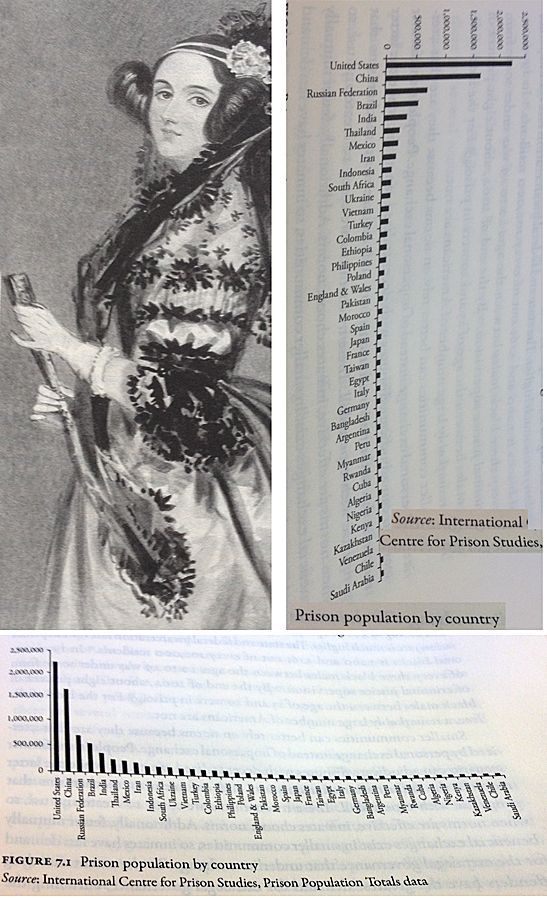
Ada Lovelace image courtesy Hulton Archive/Getty images. The graph of prison population by country has as its source the International Centre for Prison Studies. It is duplicated as an upright image also to facilitate reading.
Skarbek’s book is similarly meticulously annotated. A lecturer in Political Economy at King’s College London, his “research uses comparative institutional analysis to examine how extralegal governance institutions form, operate, and evolve, and in particular how people define and enforce property rights and trade in the absence of strong, effective governments.”
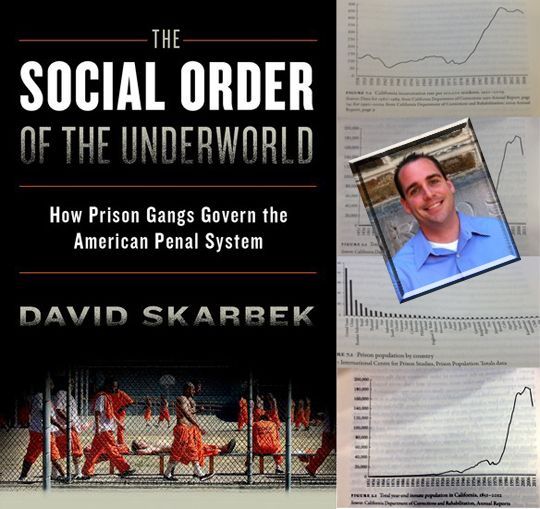
Photo credit David Skarbek: Mercatus Center, George Mason University
Essentially Skarbeck says of California’s prisons that when their size was reasonable, the system worked. Inmates followed the “convict code” and their behavior was both understandable and appropriate. But when the prisons became overcrowded with younger and more violent inmates everything changed. Gangs formed. It was the only way prisoners could get governance and protection. The gangs were racist even if the new inmates were not. The new arrivals had to change for their own protection. The prison gangs had a hierarchy, often had written constitutions, and even had inmates who were their designated “soldiers.” And the prison gangs ruled the street gangs because, if their orders from prison were not followed, there would be reprisals against street gang members when they inevitably spent time in prison!
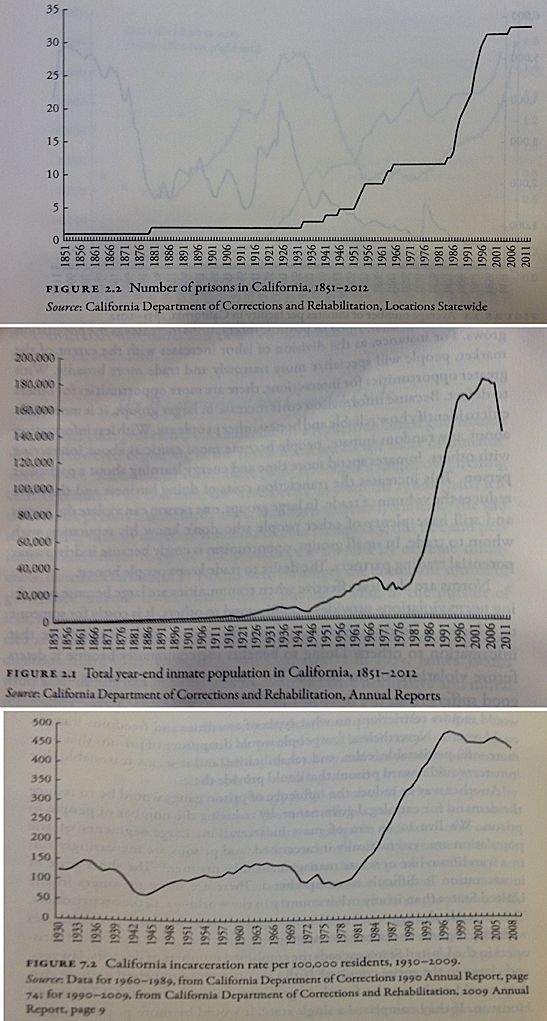
The graphs from the California Department of Corrections and Rehabilitation show (top) the number of prisons in California with the flat numbers of 1851 starting a mild rise in 1881 and rising to a total of 5 in 1946 with huge jumps in 1986. Now California spends more on prisons than on education as if no one remembers that Victor Hugo once said, “He who opens a school door closes a prison.” The 2 following graphs show the total year-end prison inmate population in California and the state’s incarceration rate per 100,000 residents 1930 to 2009.
These are, or should be, horrifying statistics. As are the numbers of persons in prison in the United States compared to other countries in that graph beside Ada Lovelace in the preceding image. Whatever we are doing isn’t working. Einstein’s possibly apocryphal quote has become a cliché but maybe insanity is doing the same thing over and over again with expectations that results are going to be different.
So if Isaacson shows us how success comes from collaboration to give one American Dream, does Skarbek suggest another form of cooperation creates a failed criminal system and the destruction of the American Dream, where people don’t live in innocent harmony? Not really. But it takes a third book, The Boys in the Boat by Daniel James Brown, to make us feel good again about the American Dream.
Brown has been quoted as saying at book talks, “It’s about a generation of Americans who fought hard, endured much, survived and prevailed. These 9 Americans, who climbed in the boat and learned to pull together, are almost the perfect metaphor for what that generation did. They endured the Depression and the war. Pull together, build great teams, get things done.”

Brown was asked if he could visit a former 1936 Olympic rowing champion who lived nearly next door to Brown’s home. The man was ill and his daughter was reading one of Brown’s previous books to him as he lay close to dying. As the author spoke with his neighbor he became electrified by his story. The 2014 book resulted. It’s a feel-good tale, beautifully told and neatly documented with likeable, almost lovable characters. The Weinstein Company has bought the movie rights. It will surely be a feel-good film.

The Northeast’s elitist Ivy League sneered at the West Coast universities rowing teams’ attempts to enter college competitions. The team the University of Washington created and trained in the mid-1930s would change that. The Boys in the Boat, the determined group that dedicated itself to what was really an impossible schedule even won the 1936 Olympics in front of Hitler.
All 3 books have been meticulously researched but succeed beyond their simple statistics to present who their subjects really are and what they have contributed to the success or failure of the American Dream. The Boys in the Boat, in particular, has given an uplift to the American Spirit. A critic has called it “Chariot of Fire with Oars.”
Photography by the author.
The Andersons, who live in San Diego, are the resident travel & cruise columnists for Physician's Money Digest. Nancy is a former nursing educator, Eric a retired MD. The one-time president of the New Hampshire Academy of Family Physicians, Eric is the only physician in the Society of American Travel Writers. He has also written 5 books, the last called The Man Who Cried Orange: Stories from a Doctor's Life.




